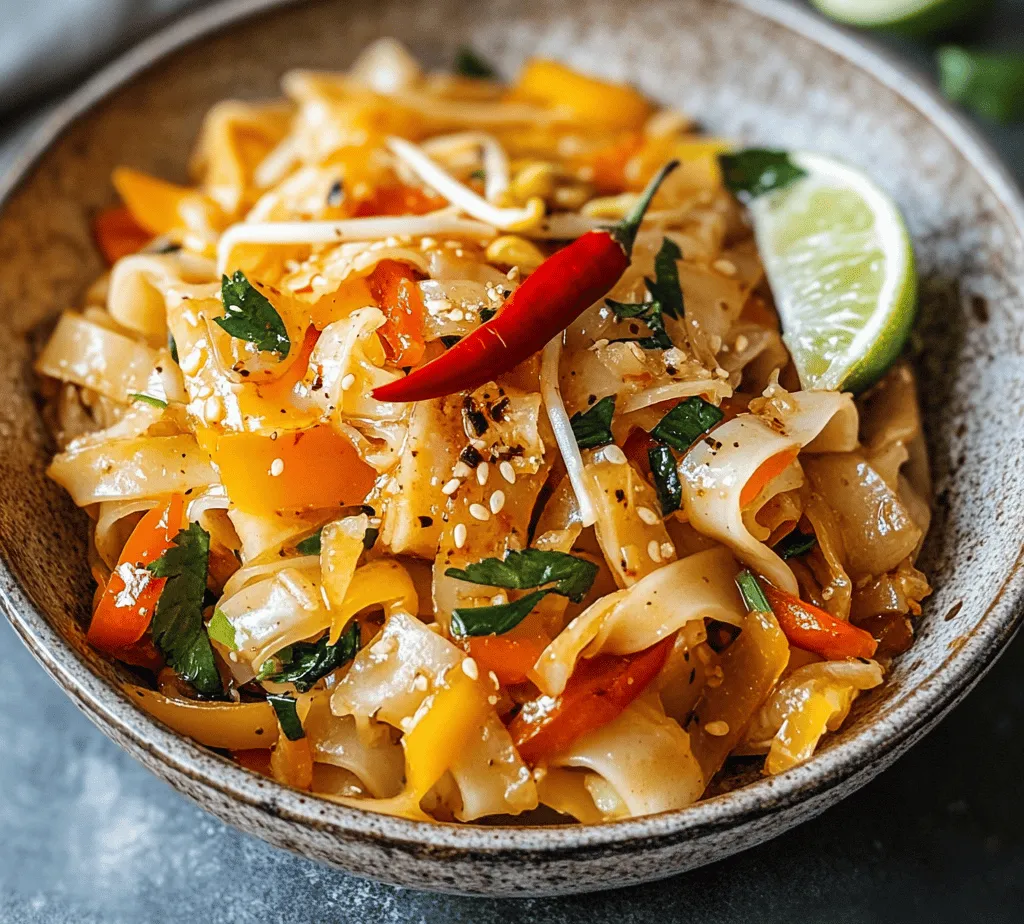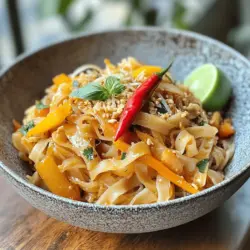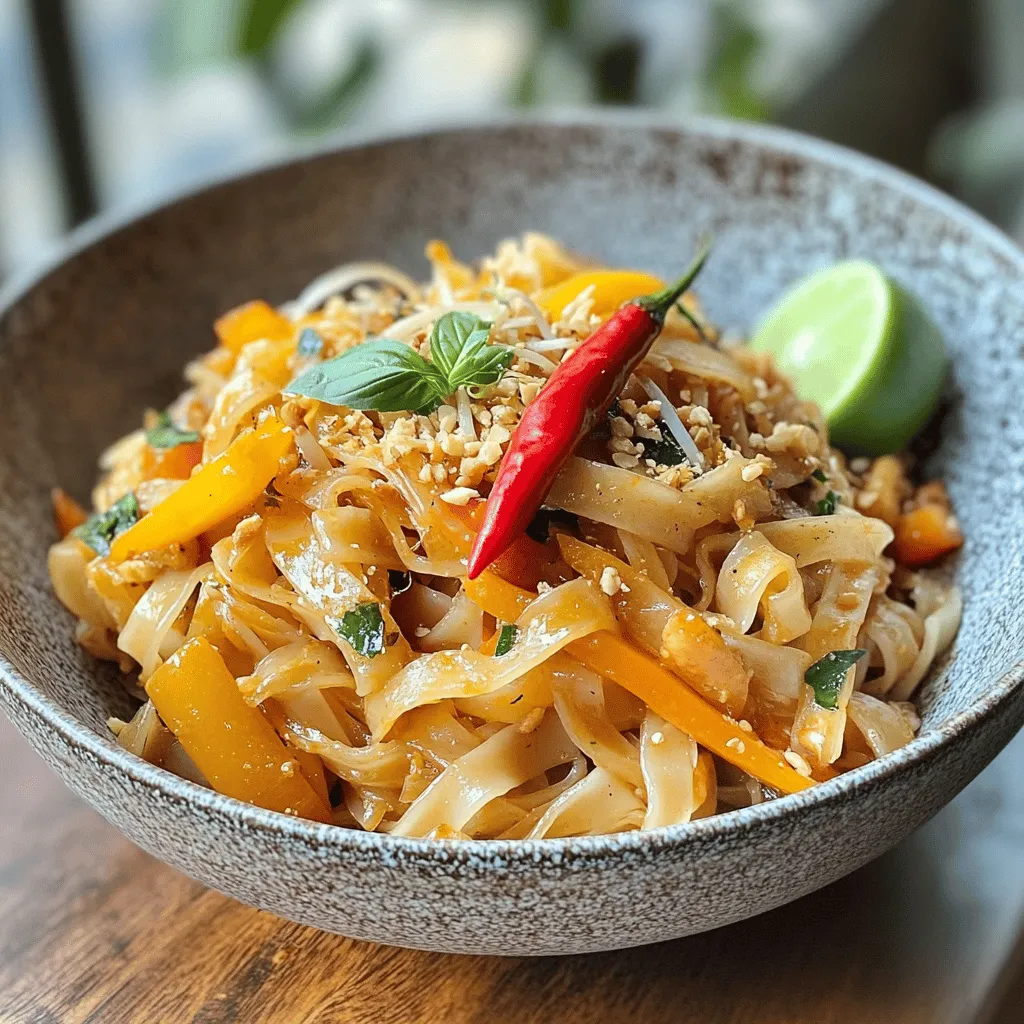Introduction
Thai cuisine is celebrated around the world for its vibrant flavors, intricate aromas, and delightful textures. Each dish tells a story through its

Techniques for Sautéing Garlic and Ginger to Maximize Flavor Without Burning
Sautéing garlic and ginger is a fundamental step in achieving the authentic flavor profile of Thai Drunken Noodles. To get the most out of these aromatic ingredients, start by finely mincing both garlic and ginger. This increases their surface area and enhances their flavor release during cooking.
Use a large skillet or a wok over medium heat to prevent burning. Add a neutral oil, such as vegetable or canola oil, and allow it to heat until shimmering. Once the oil is hot, add the minced garlic and ginger. Stir them continuously for about 30 seconds to 1 minute, watching closely for any signs of browning. The goal is to infuse the oil with their flavors without allowing them to scorch, which can lead to a bitter taste. If you notice them starting to brown too quickly, lower the heat.
This technique not only maximizes flavor but also creates a fragrant base for the rest of your dish.
Adding Vegetables
Vegetables play a vital role in Drunken Noodles, adding both texture and nutrition. When selecting vegetables, aim for a colorful mix to enhance the dish visually and nutritionally. Bell peppers are a staple, but you can also include broccoli, carrots, and snap peas for added crunch.
Guidelines for Selecting and Sautéing Bell Peppers
When choosing bell peppers, opt for ones that are firm and vibrant in color—red, yellow, or green, depending on your preference. Each color has its unique flavor profile, with red being sweeter and green having a more bitter edge.
To sauté bell peppers, slice them into thin strips for even cooking. After the garlic and ginger have been sautéed, add the bell peppers to the hot skillet. Stir-fry them for about 2-3 minutes until they begin to soften but still retain some crunch. This quick cooking method preserves their vibrant color and nutritional value.
Scrambling Eggs (Optional)
Incorporating scrambled eggs into Drunken Noodles is a delightful option that adds protein and a creamy texture to the dish. If you choose to include eggs, crack two eggs into a bowl and whisk them lightly with a pinch of salt.
After sautéing the vegetables, push them to one side of the skillet. Pour the beaten eggs into the cleared space and let them sit for a few seconds until they start to set. Then, use a spatula to scramble them gently until fully cooked. Combine the eggs with the sautéed vegetables before moving on to the next step.
Including eggs not only enhances the dish’s richness but also provides a satisfying contrast to the chewy noodles.
Combining Ingredients
The next step is to bring all the components together. Start by adding the cooked noodles to the skillet with the sautéed garlic, ginger, vegetables, and scrambled eggs.
Best Practices for Mixing Noodles with the Sauce
Before adding the noodles, ensure they are cooked according to the package instructions and drained well. This prevents the dish from becoming too watery. In a separate bowl, mix your sauce ingredients—soy sauce, oyster sauce, and a splash of fish sauce.
Pour the sauce over the noodle mixture in the skillet. Use tongs or a spatula to toss the noodles, ensuring an even coating of the sauce. This step is crucial for flavor distribution. Make sure to stir gently to avoid breaking the noodles, as they can become mushy if over-stirred.
Continue to sauté everything together for an additional 2-3 minutes until the noodles are heated through, and the sauce has thickened slightly, coating the noodles perfectly.
Final Touches
Timing is essential when adding fresh ingredients to your Drunken Noodles. Once everything is combined, it’s time to enhance the dish with fresh basil and bean sprouts.
Importance of Timing When Adding Fresh Ingredients
Add a generous handful of fresh Thai basil leaves and a cup of bean sprouts just before removing the skillet from the heat. Stir them in quickly; the residual heat will wilt the basil and warm the bean sprouts without overcooking them. This technique preserves their fresh flavors and crunchy textures, providing a delightful contrast to the savory noodles.
Serving Suggestions
Presentation is key when serving Drunken Noodles. Transfer the noodles to a large serving platter or individual bowls.
Ideas for Garnishing and Presenting the Dish
Garnish with lime wedges, slices of red chili, and additional basil leaves for a pop of color and flavor. For an extra touch, you can sprinkle chopped peanuts over the top for added crunch and a nutty flavor.
Drunken Noodles are best enjoyed hot and fresh but can also be paired with a side of spring rolls or a light cucumber salad for a complete meal.
Nutritional Information
Understanding the nutritional profile of Drunken Noodles can help you appreciate its place in a balanced diet.
Analysis of the Nutritional Profile
A typical serving of Drunken Noodles contains a balance of carbohydrates from the noodles, protein from the optional eggs and meat, and an array of vitamins and minerals from the vegetables.
- Calories: Approximately 450-600 calories per serving, depending on the ingredients used.
- Carbohydrates: About 70-80 grams, primarily from the noodles.
- Protein: Roughly 15-25 grams, which can be increased with the addition of protein-rich ingredients like chicken or tofu.
- Fats: Around 10-20 grams, mainly from the cooking oil and optional protein.
Discussion on How Ingredients Contribute to a Balanced Meal
The vegetables not only provide essential nutrients but also add fiber, aiding digestion. If you choose to use lean proteins or plant-based alternatives, you can create a meal that’s not only delicious but also nourishing.
Potential Substitutions for Different Dietary Needs
For those following a vegetarian or vegan diet, substitute the oyster sauce with a plant-based alternative and omit the eggs. Tofu or tempeh can serve as excellent protein sources, enhancing the dish’s nutritional value while keeping it in line with dietary preferences.
Cultural Context and Enjoyment
Drunken Noodles, or “Pad Kee Mao,” is a beloved dish in Thai cuisine, often enjoyed as a late-night snack or a comfort food.
How Drunken Noodles Fit into Thai Dining Culture
In Thailand, this dish is typically made with flat rice noodles, stir-fried with a variety of ingredients, and served with a spicy kick. The name “Drunken Noodles” is thought to arise from its popularity among those seeking a hearty meal after a night of festivities.
Suggestions for Pairing with Beverages or Side Dishes
Pair your Drunken Noodles with a cold Thai beer or a refreshing iced tea. A light salad or some crispy spring rolls can complement the flavors beautifully, making for a well-rounded meal.
Experience of Eating Drunken Noodles in Thailand Versus at Home
Eating Drunken Noodles in Thailand provides a unique experience: the vibrant street food culture, the aromas wafting from bustling food stalls, and the dynamic atmosphere of communal dining. While recreating this dish at home may not replicate the exact ambiance, the rich flavors and satisfying textures can transport you to the streets of Thailand with every bite.
Conclusion
Thai Drunken Noodles are a delicious and satisfying dish that combines the essence of Thai cuisine with simple yet flavorful ingredients.
Recap of the Key Points Covered
From mastering the sauté of garlic and ginger to selecting the right vegetables and ensuring a perfect mix of flavors, each step is designed to enhance the dish’s authenticity. The addition of fresh ingredients right at the end ensures maximum flavor and texture, while thoughtful garnishing brings the dish to life.
Reinforcement of the Dish’s Appeal and Flavor Profile
With its bold flavors, vibrant colors, and satisfying textures, Drunken Noodles are a feast for the senses. The balance of spicy, sweet, and savory notes creates an unforgettable dining experience.
Encouragement to Try Making the Dish at Home for a Taste of Thailand
Whether you’re an experienced cook or a novice in the kitchen, making Drunken Noodles at home is an enjoyable adventure and a great way to bring a taste of Thailand to your table.
Final Thoughts on the Joy of Cooking and Sharing Thai Cuisine
Cooking is not just about the food; it’s about the love and care you put into it. Share this delightful dish with family and friends, and savor the joy that comes from enjoying authentic Thai flavors together. Embrace the culinary journey and let your kitchen be a gateway to Thailand through the incredible experience of preparing and sharing Drunken Noodles.


